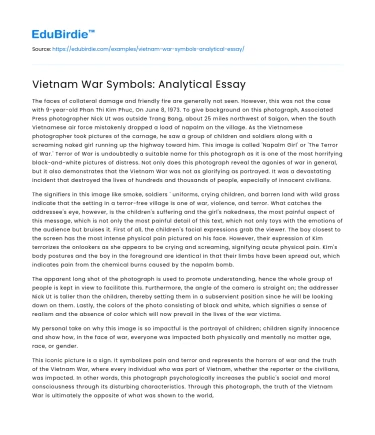The faces of collateral damage and friendly fire are generally not seen. However, this was not the case with 9-year-old Phan Thi Kim Phuc, On June 8, 1973. To give background on this photograph, Associated Press photographer Nick Ut was outside Trang Bang, about 25 miles northwest of Saigon, when the South Vietnamese air force mistakenly dropped a load of napalm on the village. As the Vietnamese photographer took pictures of the carnage, he saw a group of children and soldiers along with a screaming naked girl running up the highway toward him. This image is called 'Napalm Girl' or 'The Terror of War.' Terror of War is undoubtedly a suitable name for this photograph as it is one of the most horrifying black-and-white pictures of distress. Not only does this photograph reveal the agonies of war in general, but it also demonstrates that the Vietnam War was not as glorifying as portrayed. It was a devastating incident that destroyed the lives of hundreds and thousands of people, especially of innocent civilians.
The signifiers in this image like smoke, soldiers ' uniforms, crying children, and barren land with wild grass indicate that the setting in a terror-free village is one of war, violence, and terror. What catches the addressee's eye, however, is the children's suffering and the girl's nakedness, the most painful aspect of this message, which is not only the most painful detail of this text, which not only toys with the emotions of the audience but bruises it. First of all, the children's facial expressions grab the viewer. The boy closest to the screen has the most intense physical pain pictured on his face. However, their expression of Kim terrorizes the onlookers as she appears to be crying and screaming, signifying acute physical pain. Kim's body postures and the boy in the foreground are identical in that their limbs have been spread out, which indicates pain from the chemical burns caused by the napalm bomb.
Save your time!
We can take care of your essay
- Proper editing and formatting
- Free revision, title page, and bibliography
- Flexible prices and money-back guarantee
The apparent long shot of the photograph is used to promote understanding, hence the whole group of people is kept in view to facilitate this. Furthermore, the angle of the camera is straight on; the addresser Nick Ut is taller than the children, thereby setting them in a subservient position since he will be looking down on them. Lastly, the colors of the photo consisting of black and white, which signifies a sense of realism and the absence of color which will now prevail in the lives of the war victims.
My personal take on why this image is so impactful is the portrayal of children; children signify innocence and show how, in the face of war, everyone was impacted both physically and mentally no matter age, race, or gender.
This iconic picture is a sign. It symbolizes pain and terror and represents the horrors of war and the truth of the Vietnam War, where every individual who was part of Vietnam, whether the reporter or the civilians, was impacted. In other words, this photograph psychologically increases the public's social and moral consciousness through its disturbing characteristics. Through this photograph, the truth of the Vietnam War is ultimately the opposite of what was shown to the world, making it a very significant piece of historical evidence.






 Stuck on your essay?
Stuck on your essay?

